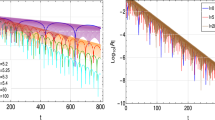The Einstein field equation, coupled to the scalar field, is studied in a spherically symmetric comoving system. The problem is translated into the language of the Newman Penrose formalism that is based on the choice of a null tetrad frame. The corresponding (tabulated) Einstein field equation, Bianchi identities and scalar field equation are explicited in terms of the Weyl and Ricci scalars and discussed. Spherical symmetry reduces the difficulties but not so far to enable to integrate the scheme in general. The main result is that static self-gravitation is possible only for massless scalar field. The static solution is determined. It depends on an arbitrary function that can be interpreted as radial coordinate. The part of the space–time solution of the problem does not contain black holes. It is remarked that in the part of the space–time not solution of the problem, light rays cannot propagate radially but admit circular orbits.
Similar content being viewed by others
References
Abraham, M. A. and Evans, C. R. (1993). Critical behavior and scaling in vacuum axisymmetric gravitational collapse. Physical Review Letters 70, 2980.
Chandrasekhar, S. (1983). The Mathematical Theory of Black Holes, Oxford University Press, Oxford.
Choptuik, M. W. (1993). Universality and scaling in gravitational collapse of a massless scalar field. Physical Review Letters 70, 9.
Choptuik, M. W., Hirshman, E. W., Lieblig, S. L., and Pretoriou, F. (2003). Critical collapse of the massless scalar field in axisymmetry. Physical Review D68, 044007.
Christodoulou, D. (1986). The problem of self-gravitating scalar field. Communications in Mathematical Physics 105, 337.
Christodoulou, D. (1987). A mathematical theory of gravitational collapse. Communications in Mathematical Physics 106, 613.
Evans, C. R. and Coleman, J. S. (1994). Critical phenomena and self-similarity in the gravitational collapse of radiation fluid. 72, 1782.
Hirshman, E. W. and Eardley, D. M. (1995a). Universal scaling and echoing in the gravitational collapse of a complex scalar field. Physical Review D51, 4198.
Hirshman, E. W. and Eardley, D. M. (1995b). Critical exponents and stability at the black hole threshold for a complex scalar field. Physical Review D52, 5850.
Krasinski, A. (1997) Inhomogeneous Cosmological Models, Cambridge University Press, Cambridge.
Newman, E. and Penrose, R. (1962). An Approach to Gravitational Radiation by a Method of Spin Coefficients. Journal of Mathematical Physics 3, 566.
Penrose, R. (1968). Structure of space–time. In: de Witt, M. and Wheeler, J. A. (Eds.), Battelle Rencontres: 1967 Lectures in Mathematical Physics, Benjamin, New York.
Penrose, R. and Rindler, W. (1984). Spinors and Space–Time, Cambridge University Press, Cambridge.
Sachs, R. (1961). Gravitationa waves in general relativity. VI. The outgoing radiation condition. Proceedings of the Royal Society of London, Series A, 264, 309.
Whang, A. (2003). Critical collapse of a cylindrically symmetric scalar field in four-dimensional Einstein's theory of gravity. Physical Review D68, 064006.
Weinberg, S. (1972). Gravitation and Cosmology, Wiley, New York.
Zecca, A. (1993). Some remarks on Dirac's equation in the Tolman-Bondi geometry. International Journal of Theoretical Physisc 32, 615.
Zecca, A. (2000). Weyl spinor and solutions of massless free field equation. International Journal of Theoretical Physisc 39, 377.
Zecca, A. (2001). Static solutions of gravitating scalar and matter field in spherically symmetric comoving systems. Il Nuovo Cimento B116, 169.
Zecca, A. (2003). Self gravitating scalar field in spherically symmetric comoving system: Solutions depending on one variable. Il Nuovo Cimento B118, 953.
Zecca, A. (2004). Static massless and time dependent massive self gravitating scalar field in spherically symmetric comoving system. Il Nuovo Cimento B119, 521.
Author information
Authors and Affiliations
Corresponding author
Rights and permissions
About this article
Cite this article
Zecca, A. Comoving Self-Gravitating Scalar Field in the Newman Penrose Formalism. Int J Theor Phys 45, 375–383 (2006). https://doi.org/10.1007/s10773-006-9028-0
Received:
Accepted:
Published:
Issue Date:
DOI: https://doi.org/10.1007/s10773-006-9028-0



